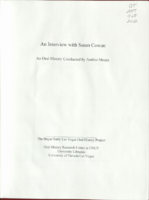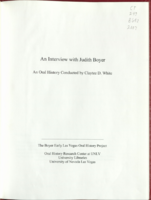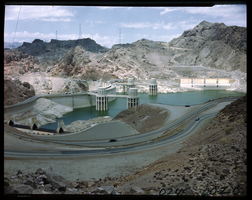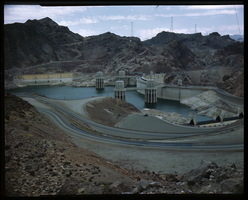Search the Special Collections and Archives Portal
Search Results

Transcript of interview with Susan Cowan by Andres Moses, January 31, 2006
Date
Archival Collection
Description
Text

Transcript of interview with Judith Boyer by Claytee D. White, November 8, 2005
Date
Archival Collection
Description
Text

Film transparency of Hoover (Boulder) Dam, taken from the upstream side of the dam on the Arizona side, May, 1947
Date
Archival Collection
Description
Image

Film transparency of Hoover (Boulder) Dam, taken from the upstream side of the dam on the Nevada side, May, 1947
Date
Archival Collection
Description
Image
Flora and Stuart Mason Photographs and Event Programs
Identifier
Abstract
Collection is comprised of photographs of Las Vegas, Nevada community leaders Flora and Stuart Mason and three event programs from Temple Beth Sholom (Las Vegas, Nevada). Materials date from approximately 1965 to 2010.
Archival Collection
Whitaker, Dean, 1925-
William Dean Whitaker was born in 1925 and raised in a suburb of Los Angeles,
California. Dean, as he is known, talks briefly about his parents and his brothers, for his youth quickly ended when he joined the Air Force and became an aviation cadet once he had turned 18 years old. The year was 1943 and World War II was raging. He became a member of the 398 th Bomb Group and flew twenty missions before being captured by the Germans.
Person
Freemyer, Wilma, 1919-1995
Wilma Freemyer lived in Las Vegas, Nevada for 56 years. She was born in Oklahoma City, Oklahoma on February 14, 1919. Freemyer worked as an advertising manager for the Las Vegas Review-Journal for 42 years and was a member of the Fraternal Order of Eagles Auxiliary Arie 1213. She served as president of the Eagles Auxiliary in 1956. She died in Las Vegas, Nevada on July 8, 1995.
Person
Hugo Chuc oral history interview
Identifier
Abstract
Oral history interview with Hugo Chuc conducted by Elsa Lopez on December 6, 2018 for the Latinx Voices of Southern Nevada Oral History Project. In this interview, Hugo Chuc discusses growing up in Guatemala and moving to the United States. His early life was often unstable due to economic difficulties. Once Hugo turned nineteen, he made the journey to the United States and remained in California for a few years. When the cost of living became too much, Chuc and his family moved to Las Vegas, Nevada. He found work at Apex Construction, where he was first introduced to the Culinary Union. Chuc became increasingly involved in union work, despite the backlash he received from his employers.
Archival Collection
Patrice Johnson oral history interview
Identifier
Abstract
Oral history interview with Dr. Patrice Johnson conducted by Kiley Veigel on November 16, 2009 for the Public School Principalship Oral History Project. In this interview, Johnson reflects upon her more than 20-year career as a teacher and school administrator in California and in the Clark County School District. She discusses her upbringing and how she always wanted to be a teacher, her training to become a teacher, and experiences in teaching. She describes her path to becoming a school principal, and eventually assistant superintendent for the Clark County School District. She also discusses how her family life has shaped her approach to teaching, in addition to regular job duties that she faced as a teacher and administrator.
Archival Collection
Barry Gunderson oral history interview
Identifier
Abstract
Oral history interview with Barry Gunderson conducted by Scott Fiszer on October 18, 2002 for the Public School Principalship Oral History Project. In this interview, Gunderson reflects upon his 28-year career as a teacher and administrator with Nevada’s Clark County School District (CCSD). He discusses his approach to school administration, his regular responsibilities, and some of his biggest challenges. He offers suggestions for individuals interested in pursuing school administration, and uses his own experiences to give examples of having to make difficult decisions as an administrator.
Archival Collection
